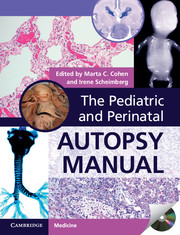Book contents
- Frontmatter
- Contents
- List of contributors
- Foreword
- Preface
- Acknowledgments
- 1 Perinatal autopsy, techniques, and classifications
- 2 Placental examination
- 3 The fetus less than 15 weeks gestation
- 4 Stillbirth and intrauterine growth restriction
- 5 Hydrops fetalis
- 6 Pathology of twinning and higher multiple pregnancy
- 7 Is this a syndrome? Patterns in genetic conditions
- 8 The metabolic disease autopsy
- 9 The abnormal heart
- 10 Central nervous system
- 11 Significant congenital abnormalities of the respiratory, digestive, and renal systems
- 12 Skeletal dysplasias
- 13 Congenital tumors
- 14 Complications of prematurity
- 15 Intrapartum and neonatal death
- 16 Sudden unexpected death in infancy
- 17 Infections and malnutrition
- 18 Role of MRI and radiology in post mortems
- 19 The forensic post mortem
- 20 Appendix tables
- Index
- References
19 - The forensic post mortem
Published online by Cambridge University Press: 05 September 2014
- Frontmatter
- Contents
- List of contributors
- Foreword
- Preface
- Acknowledgments
- 1 Perinatal autopsy, techniques, and classifications
- 2 Placental examination
- 3 The fetus less than 15 weeks gestation
- 4 Stillbirth and intrauterine growth restriction
- 5 Hydrops fetalis
- 6 Pathology of twinning and higher multiple pregnancy
- 7 Is this a syndrome? Patterns in genetic conditions
- 8 The metabolic disease autopsy
- 9 The abnormal heart
- 10 Central nervous system
- 11 Significant congenital abnormalities of the respiratory, digestive, and renal systems
- 12 Skeletal dysplasias
- 13 Congenital tumors
- 14 Complications of prematurity
- 15 Intrapartum and neonatal death
- 16 Sudden unexpected death in infancy
- 17 Infections and malnutrition
- 18 Role of MRI and radiology in post mortems
- 19 The forensic post mortem
- 20 Appendix tables
- Index
- References
Summary
Introduction to forensic death investigation
The field of pediatric forensic pathology (PFP) refers to the subspecialty of forensic medicine that is specific to cases of injury or death in children. These cases include sudden unexpected death in infancy (SUDI–SIDS spectrum fatalities), childhood accidents, iatrogenic injuries, inflicted injuries, and cases with suspicion of neglect. The forensic pathologist (FP) is specially trained in the subspecialty of pathology that includes the interpretation of findings in deceased individuals to determine cause (COD) and manner of death (MOD); interpretation of the significance of clinical findings to COD and MOD; correlation and reconstruction of wounds, determination of wound patterns, wound sequences, and timing; and coordination and/or performance of comprehensive medico-legal death investigations.
The circumstances under which and when a death is reported to the forensic pathologist, coroner, or medical examiner varies by region and circumstance. Generally, the death of a child is reported if an unexpected death occurs outside the hospital, in the emergency room (ER), and/or in any deaths that may be due entirely or in part to any factor other than natural disease.
Pediatric pathologists (PPs) are an important resource for the medico-legal process. The findings of the PP/FP/PFP bring different experience, training, and expertise to forensic analysis of the seriously injured child or childhood fatality. In some jurisdictions the PP has developed relationships with the medical examiner or coroner’s office and is routinely involved in child fatality cases. Pediatric pathologists can provide important input on diseases and conditions that may mimic traumatic or abusive injury, experience with diseases and conditions of infancy and childhood, special techniques and clinical resources for the complex pediatric post mortem and special testing resources and insights into the effects of prolonged life support and complications of critical care. Ideally, in challenging cases the experience of both forensically trained and pediatric pathologists serve to better the analytical process. In complex cases, the PP is an important resource to the final determinations of causation.
- Type
- Chapter
- Information
- The Pediatric and Perinatal Autopsy Manual , pp. 376 - 408Publisher: Cambridge University PressPrint publication year: 2000

